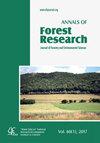Comparison of various growth functions for predicting long-term stand development associated with different initial spacing in 64-year-old Japanese cedar (Cryptomeria japonica (L.f.) D. Don) plantations
IF 1.7
3区 农林科学
Q2 FORESTRY
引用次数: 1
Abstract
Establishing a plantation with varied distances between trees is one way to control stand density. Understanding how stand growth patterns are influenced by initial spacing can help maximize growth and yield. The purpose of this study was to examine the long-term effects of different patterns of initial tree spacing on stand development. A spacing trial with 5 initial distances, namely, treatments I: 1×1 m, II: 2×2 m, III: 3×3 m, IV: 4×4 m and V: 5×5 m, was installed in 1950 on Japanese cedar ( Cryptomeria japonica ) plantations in central Taiwan, managed by the Experimental Forest of National Taiwan University. Each treatment had 3 repeated plots, and all the plots were surveyed from 1955 to 2014, with 8 records for each time series. We simultaneously employed 6 growth functions to predict stand basal area growth for each plot and assessed their predictability using the root mean square error (RMSE) as a criterion. Consequently, a total of 15 plots covering all the treatments, each with 6 RMSEs resulting from various models, were obtained. The repeated measures analysis of variance approach was adopted to compare predictability among models. The Richards growth function stood out from all the other models. As a result, this model was used to analyze stand development following different initial spacing. We found that the predicted curves could effectively exhibit the growth patterns resulting from different initial spacing. Moreover, the parameters help explain some characteristics of stand development, such as the growth potential and the maximum growth rate achieved ( t max ). As a result, a clear trend emerged, showing that the growth potential increased, whereas the tmax decreased with decreasing initial spacing. These results provided valuable information for managing the stand density of this conifer.不同初始间距对64年生杉木(Cryptomeria japonica, L.f.)林分长期发育预测的生长函数比较Don)种植园
建立不同间距的人工林是控制林分密度的一种方法。了解林分生长模式如何受到初始间距的影响有助于最大限度地提高生长和产量。本研究旨在探讨不同初始树距模式对林分发育的长期影响。1950年,在国立台湾大学实验林管理的台湾中部杉木人工林上进行了5个初始间距试验,即I: 1×1 m、II: 2×2 m、III: 3×3 m、IV: 4×4 m和V: 5×5 m。每个处理有3个重复样地,所有样地的调查时间为1955 - 2014年,每个时间序列有8条记录。同时采用6种生长函数预测每个样地林分基面积的生长,并以均方根误差(RMSE)为标准评估其可预测性。因此,共获得15个样地,覆盖所有处理,每个样地的rmse为6。采用重复测量方差分析方法比较各模型的可预测性。理查兹生长函数从所有其他模型中脱颖而出。利用该模型对不同初始间距下林分发育进行了分析。结果表明,预测曲线能较好地反映不同初始间距下的生长模式。此外,这些参数还有助于解释林分发育的一些特征,如生长潜力和最大生长率(t max)。结果表明,随着初始间距的减小,生长潜力增大,tmax减小。这些结果为该针叶林的林分密度管理提供了有价值的信息。
本文章由计算机程序翻译,如有差异,请以英文原文为准。
求助全文
约1分钟内获得全文
求助全文
来源期刊

Annals of Forest Research
FORESTRY-
CiteScore
2.20
自引率
11.10%
发文量
11
审稿时长
12 weeks
期刊介绍:
Annals of Forest Research is a semestrial open access journal, which publishes research articles, research notes and critical review papers, exclusively in English, on topics dealing with forestry and environmental sciences. The journal promotes high scientific level articles, by following international editorial conventions and by applying a peer-review selection process.
 求助内容:
求助内容: 应助结果提醒方式:
应助结果提醒方式:


